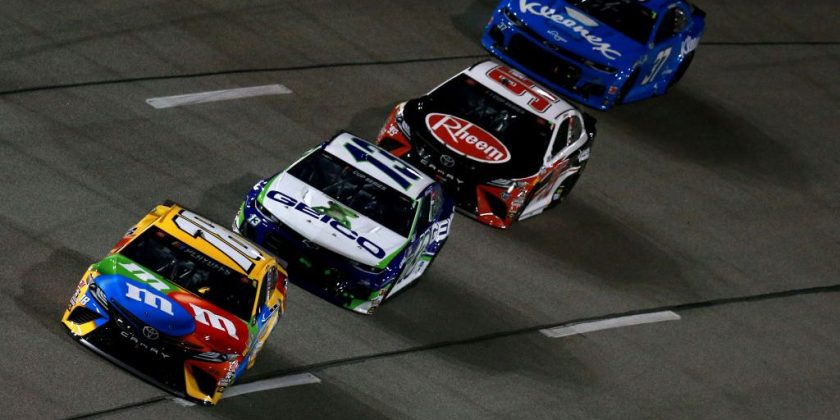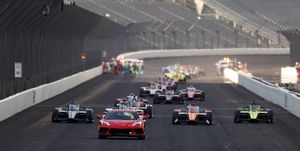
“I’m just sorry we couldn’t crash more cars today. We didn’t fill the quota for Talladega and NASCAR … Honestly, if we haven’t crashed at least 50 percent of the field by the end of the race, we need to extend the race until we crash at least 50 percent of the cars. It’s not fair to these fans to not see any more wrecks than that, any more torn-up cars. I mean, we still had over half the cars running at the end, and it shouldn’t be that way …
“I think we ought to make it a Figure Eight (race). I mean, if we could make it a Figure Eight, it would be perfect. It would absolutely be perfect here. It’d be better than what we’ve got. Or we could stop at halfway, take a break, then turn around and go backward. Then, with 10 to go, we could split the field and half of them could go in the regular direction and half could go backward.”
Tony Stewart
May 6, 2012
—
When everything is designed to be awesome, eventually nothing will be.
More than anything else, the expectation of its own fan base is the biggest challenge NASCAR must overcome over the next decade.
Saturday’s Federated Auto Parts 400 at Richmond Raceway wasn’t an instant classic, nor did it feature any singular moment that could be repackaged into a trending social media snippet, but it absolutely was an enjoyable three hours of racing.
However, many of you don’t seem to agree.
Was Richmond a good race?
Brad Keselowski ran away at the end, leading the final 48 laps unchallenged, and claimed his fourth NASCAR Cup Series win of the season. Prior to that, there were 19 lead changes between nine different drivers, and constant side-by-side action throughout the field.
It was a stark contrast to the two races at Richmond last season, contested under the high downforce competition package, where cars were trapped single-file and unable to overcome the turbulence coming from the 8″ spoiler.
And despite claims to the contrary, there were several storylines to follow throughout Saturday night:
– Playoff underdog Austin Dillon passed Kevin Harvick early, suffered a pit road speeding penalty, but quickly raced his way back through the field to finish fourth anyway.
– Expected championship contender Ryan Blaney continued to struggle and suffered a pit mistake (loose lug nuts) that permanently trapped him deep in traffic throughout the evening.
– The lack of cautions produced two distinct tire strategy options in the second half of the race, with teams choosing either to pit once or twice, creating constant comers-and-goers with drivers on different aged tires.
– The race finished with five drivers within 16 points of each other on the playoff cutline with just one race remaining in the Round of 16.
What it didn’t feature was a single stoppage for anything other than a competition caution or the two stage breaks. It also didn’t provide a late restart to inspire multiple attempts at a green-white-checkered finish.
Is this really what we’ve become?
You told NASCAR officials you didn’t want damaged vehicles on the track because they dropped debris that naturally brought out the caution. You told NASCAR to get them out of the way of the leaders. They instituted a damaged vehicle policy.
Now some of you want NASCAR to have more cautions. You can’t make this up.
The argument can be made, as Clint Bowyer (and others) did after the race, that the Phoenix – New Hampshire tire combination wasn’t the right compound for Richmond.
“I think something is not meshing with the track,” Bowyer said. “You look out there on the racetrack — and all night long it’s had a lot of racing on it this weekend — and it looks like a highway out there.
“It wasn’t putting any rubber down on the track and they’ve got to do a better job of that. That’s unacceptable as far as I’m concerned.”
Drivers have told Goodyear officials for years that it needed to bring a more reliable and predictable tire. It has.
“I’m a fan of this sport and we’re going to ask fans to come back one of these days and we’ve got to put a better show on than that,” Bowyer continued. “We can’t have it run lap after lap after lap with no cautions. Something’s got to change there and the first thing I’d change if I owned it would be the tire.”
Is Bowyer saying NASCAR isn’t a show unless there is copious amounts of crashing?
NASCAR has marketed itself about the chaos for so long that many of you aren’t satisfied unless it’s manufactured for you. It’s a television program that thrives on endless schadenfreude.
It’s not a secret across the industry, either.
The @JimmieJohnson headline reminds me of something I’ve been thinking about:@F1 is still where you go to see the most advanced motorsport product. @NASCAR is where you go to see motorsport presented as entertainment. @IndyCar is where you go simply to see racers racing.
Here’s the thing about the pursuit of entertainment at the expense of sporting integrity. It will never ever be enough. NASCAR implemented a 10-driver playoff and expanded it to 12. It infamously added a 13th driver to the 12 following Spingate in 2013.
That, in turn, led to the current 16-driver elimination showdown.
NASCAR was accused of throwing debris cautions for benefit of the show. Accurate or not, it legitimized the debris cautions in the form of stage racing. We currently have three stages per race, with a competition caution thrown in every week due to COVID-19, with NASCAR openly discussing the addition of splitting races into quarters next season.
The high downforce, low horsepower rules package was designed to keep drivers on the throttle — neutering a significant part of the skillset that made them great in the first place — all for the sake of keeping cars bunched closer together.
It’s so visibly challenging to pass with this package that races often come down to a series of four-wide restarts and crashes designed to trend on Twitter.
The #SunocoRookie restarted in P5 and took the checkered flag. 🏁@ColeCuster’s run at @KySpeedway is what racing dreams are made of! pic.twitter.com/boTWmE6LkP
Overtime finishes are becoming the expectation and not an occasional necessity.
This is what you’ve encouraged NASCAR president Steve Phelps to aim towards, in his own words, last July at Daytona.
“What we are looking for is, ‘what is the most entertaining racing that we can put out there?’ That is what we are trying to do,” Phelps said. “And if that means full-throttle racing, that’s the package we are going to put out there.”
Listen, things evolve.
The National Football League has adopted two-point conversions, instant replay and the 4th-and-15 alternative to the onside kick.
That’s evolution.
But when a race like Saturday needs to be addressed, and the suggestions all involve generating more crashing or manipulation of the natural flow of a race with more arbitrary stoppages, that’s not evolution.
That’s a mutation.
And that in turn leads to this kind of messaging from some of the most influential personalities in the sport.
LOL sports is entertainment. Nothing more. Nothing less.
So where does that end?
Let’s say NASCAR adds the fourth stage. What comes next? Fans have proven themselves to be increasingly critical of any race that doesn’t end under green-white-checkered conditions.
I’d say a caution with about 20 laps to go!!
The NASCAR sanctioned Late Model Stock race held annually at Martinsville Speedway featured an automatic caution with 10 laps to go for years. It then added a 10-car invert alongside the automatic shootout.
It was absolute chaos, and everything this particular subset of the NASCAR fan base wants to see every week, but only ended when Dale Earnhardt Jr. threatened to pull his two cars from from the event.
“I don’t even know if I’m going to bring my cars back because of that caution with 10 laps to go,” Earnhardt said. “Man, we just can’t afford to tear our shit up every time we come down here. I mean my drivers love it. It’s a prestigious race, but it’s killing us to come in here and run every year.
“Otherwise without that caution it is pretty awesome. It’s just a tough deal for us. We know that if we even get that far we have a high chance of tearing our car up.”
Track president Clay Campbell eventually relented but not before offering this impassioned argument for the rule.
“To pay $25,000-to-win and $1,000-to-start, it’s not your typical race,” Campbell said. “We wanted to do something to make it exciting for the fans. We put that competition caution in with 10 laps to go and it’s been a staple of this event.”
Fast forward to a hypothetical Phelps from a dystopian 2025.
“This is the Cup Series, it’s the highest level of the sport,” Hypothetical Phelps said. “We wanted to do something to make it exciting for the fans. We put that competition caution in with 10 laps to go and it’s been a staple of our series.”
And it went unchallenged by those responsible for holding NASCAR accountable.
TV doesn’t pay $1 billion for authenticity, sorry. They pay for entertainment.
So just admit it:
If Saturday’s race was anything less than ‘fine’ race by your standards, you’re here for crashing and late race chaos. By any respectable measure, that’s not racing. It’s a demolition derby. And that’s not a sport.
It’s entertainment at any cost.
Source: Read Full Article

